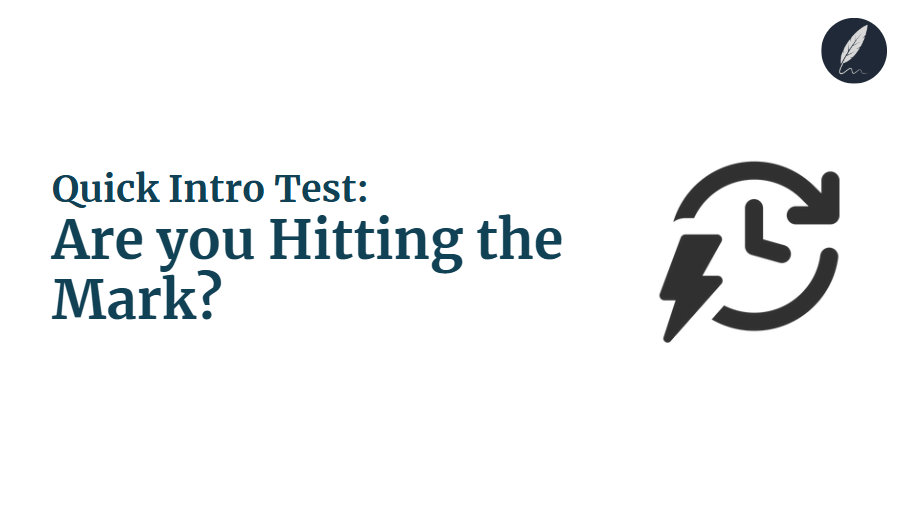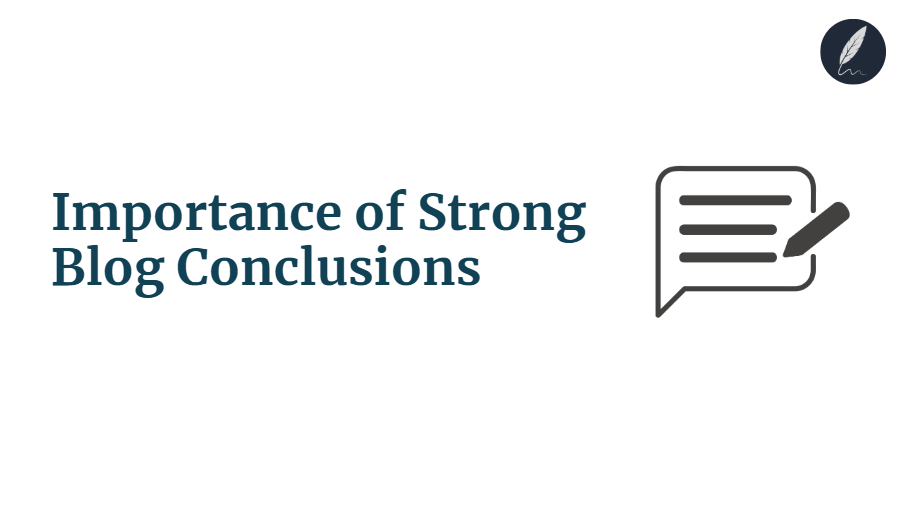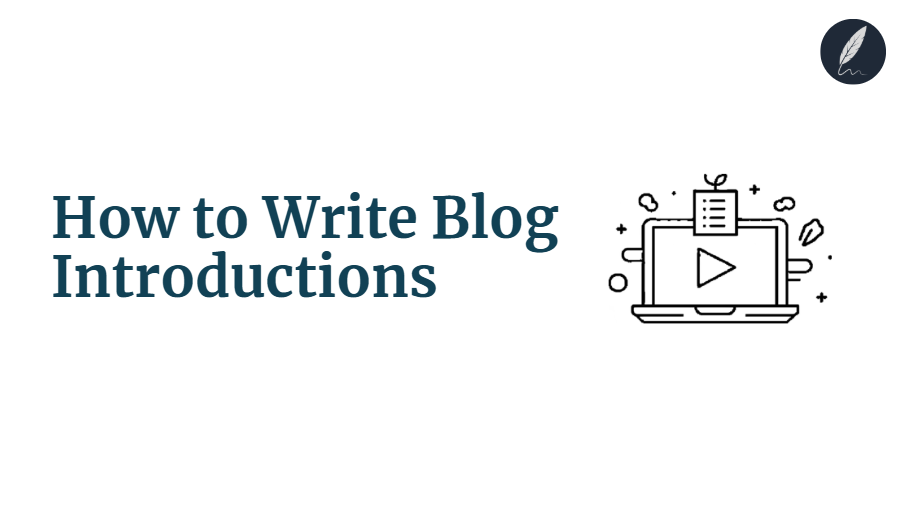Ever publish an article only to watch readers bounce within seconds?
Your introduction might be failing the crucial “sniff test”, that instant moment when readers decide whether to stay or click away.
A weak intro can sabotage even your best content, while a strong one hooks readers immediately and keeps them scrolling.
The good news? You can quickly test if your intro hits the mark using proven evaluation methods that reveal exactly what’s working and what’s not.
Key Takeaways
- Sniff Test: Run a rapid mental check for common red flags like rambling, vague openings, or buried main points that drive readers away instantly.
- 5-Second Check: Ask five critical questions - Does it grab attention? Is the topic clear? Does it set expectations? Is it concise? Does it make you want more?
- Read Aloud: Listen to your intro spoken out loud to catch awkward phrasing, run-on sentences, and flow issues your eyes might miss.
- Hook Effectiveness: Test if your opening immediately sparks curiosity, promises clear value, or presents an intriguing challenge that compels continued reading.
- Grammar Matters: Polish your introduction thoroughly since it’s readers’ first impression of your writing skills and credibility.
- Clear Purpose: Ensure your intro acts like a roadmap, clearly stating what the article covers and what questions it will answer.
The “Sniff Test”: Instant Red Flags for Your Intro
Imagine your introduction is a quick interview. The “sniff test” is a rapid scan that helps you identify signs of a bad introduction instantly.
If your intro fails this quick mental check, it’s often a sign that readers will click away without a second thought.
This section guides you through common pitfalls, offering a quick intro test to see if your opening paragraphs are truly hitting the mark.
A strong introduction acts as a friendly welcome, clearly stating what your article is about and why it matters to the reader.
A weak one, however, can act as a roadblock, causing confusion or boredom. Learning how to know if my intro is good often starts with recognizing what makes it ineffective.
Common Pitfalls That Drive Readers Away
To check intro effectiveness and make sure your readers stick around, watch out for these frequent issues:
- Too Long and Rambling: Your introduction shouldn’t be a marathon. If it goes on and on, readers can quickly lose interest before they even reach your main points. Introductions that are too long often bury the actual topic under excessive background information or unrelated details. This leads to early disengagement, which means your content might not perform as well as it could.
- Example: An article on “quick intro test” that starts with three paragraphs explaining the entire history of writing introductions.
- Actionable Insight: Aim for conciseness. Get to the point quickly and respect your reader’s time. A good rule of thumb: if it doesn’t hook the reader or set the stage for this specific article, it probably doesn’t belong in the intro.
- Vague or Ambiguous Opening: Your introduction should be like a clear signpost. If it’s too general or doesn’t clearly state your topic, readers will be confused about what they’re supposed to be reading. They might wonder if they’ve landed on the right page at all. This lack of clarity is a major sign of a bad introduction.
- Example: “In today’s fast-paced world, communication is more important than ever…” (Instead of clearly stating what specific communication challenge the article will address).
- Actionable Insight: Be direct and clear from the very first sentence. Immediately tell readers what your article is about and why it’s relevant to them.
- Missing a Clear Hook or Value Proposition: Think of your hook as the bait that draws readers in. If your introduction doesn’t immediately grab attention, spark curiosity, or explain how the reader will benefit, they have no reason to continue. This is crucial for effective intro writing tips.
- Example: A bland, generic statement like “This article discusses the importance of good writing.”
- Actionable Insight: Start with something compelling. This could be a surprising fact, a thought-provoking question, a relatable problem, a bold statement, or a clear promise of unique insight. This directly answers how to know if my hook is effective.
- Burying the Lead (Crucial Information is Delayed): The most important information, your main argument, or the solution you’re promising should appear early in your introduction. If you delay it, readers might not stick around long enough to find it. This defeats the purpose of an article that aims to help or inform.
- Example: An article about a groundbreaking new AI tool spending five sentences on the general history of AI before introducing the tool itself.
- Actionable Insight: Get straight to the point. Tell readers upfront what to expect. This confirms their click was worthwhile and encourages them to keep reading.
- Excessive Jargon or Technical Language: Using too many industry-specific terms, acronyms, or complex words without explaining them can alienate a wider audience. Your test written introduction should ensure that everyone, regardless of their background, can understand your opening.
- Example: An article for general freelancers immediately diving into “synergistic content monetization through omnichannel outreach” without defining terms.
- Actionable Insight: Always write for your target audience. Simplify complex concepts or provide immediate, concise explanations.
- Lacking Proper Context or Setting the Scene: Jumping directly into detailed points or solutions without first giving readers the necessary background, problem statement, or the “why” behind your article can be confusing. Readers need a little bit of scene-setting to understand the importance of what follows.
- Example: Discussing solutions for “content decay” without first explaining what content decay is or why it’s a problem.
- Actionable Insight: Briefly establish the ‘what’ and ‘why’ before diving into the ‘how’. Provide just enough context to orient the reader, then move into your main content.
- No Clear Purpose or Thesis Statement: A strong introduction tells the reader exactly what the article will cover and what questions it will answer. If your introduction feels like a general observation rather than a clear roadmap, it leaves readers wondering about the article’s true purpose.
- Example: An intro that reads like a rambling thought, rather than a clear promise of specific information or a defined scope.
- Actionable Insight: Clearly define the scope and objective of your article within the introduction. Give your reader a clear roadmap for what they are about to learn or gain.
Your Self-Assessment Checklist: A Rapid-Fire Evaluation
After giving your introduction a quick “sniff test” for obvious red flags, it’s time for a more focused, rapid-fire evaluation.
This section provides a simple, good introduction checklist designed for immediate self-correction. It’s your personal quick intro test that you can perform in seconds, greatly enhancing your self-edit introduction skills before anyone else reads your work.
This checklist helps you move from spotting problems to actively confirming your introduction’s strengths.
The 5-Second Intro Check
Ask yourself these five questions. A “No” to any of them means your introduction likely needs some work.
- Does it grab attention immediately? (Yes/No)
- Tip: Imagine you’re a busy reader scrolling quickly through many articles. Would these first few sentences make you pause and genuinely want to read more? If it feels boring even to you, it will to your audience.
- Is the main topic or problem crystal clear? (Yes/No)
- Tip: Could someone who has only read your introduction tell you exactly what your article is about, or what core issue it aims to solve? Avoid making your reader guess.
- Does it clearly tell the reader what to expect from the article? (Yes/No)
- Tip: Does your introduction set the right expectations for the content that follows? It should act like a mini-map, outlining the scope or the key areas you’ll cover, so readers know what they’re investing their time in.
- Is it concise and to the point? (Yes/No)
- Tip: Read each sentence. Can any words, phrases, or even entire sentences be removed without losing meaning or impact? Avoid unnecessary fluff and get straight to the point. Every word should earn its place.
- Does it make you want to read more? (Yes/No)
- Tip: Step back and read your introduction as if you didn’t write it. Does it successfully pique your curiosity, promise clear value, or present an intriguing challenge that compels you to continue reading the rest of the article?
The “Read Aloud” Test
This is a simple yet powerful test for refining your introduction.
Reading your text aloud can reveal issues that your eyes might miss during silent reading, such as awkward phrasing, run-on sentences, clunky transitions, or even minor grammatical errors that disrupt the flow.
- Actionable Insight: Your ears can often catch what your eyes overlook. When you read your introduction aloud, you hear the natural rhythm and flow of your words. If you stumble over a sentence, run out of breath, or find yourself rereading a phrase to understand it, your reader will likely have the same experience. This means it’s time to revise.
Write smarter with Orwellix
The Orwellix AI Capabilities that helps you craft clearer, more effective content.
Conclusion
By combining practical approaches like the “Sniff Test,” your “Self-Assessment Checklist,” and the simple “Read Aloud” technique, you pinpoint the effective intro mistakes and instantly get a powerful introduction by correcting those mistakes.
This ensures your content’s opening always hits the mark, delivering maximum impact and compelling readers to dive deeper.
Frequently Asked Questions (FAQs)
1. How do I know if my hook is effective?
An effective hook immediately makes the reader want to continue reading. To test written introduction and assess your hook, use the “5-Second Intro Check”: does it make you want to read more? Also, try the “Read Aloud” test to hear if it flows well and sounds engaging.
An effective hook sparks curiosity, promises clear value, or presents an intriguing challenge.
2. Does grammar in the intro really matter that much?
Yes, grammar in the introduction matters. Your introduction is the reader’s first impression of your writing skills and professionalism.
Grammatical errors or awkward phrasing can immediately damage your credibility and distract readers, making them question the quality of the rest of your content.
3. What if my introduction passes all tests but readers still bounce?
If your intro tests well but engagement is low, check if your content delivers on the promises made in your introduction.
Also ensure your topic matches what your target audience actually wants to read about. Sometimes the issue isn’t the intro quality but the topic-audience fit.
4. Can I use the same introduction formula for different types of content?
The core principles (grab attention, state topic clearly, set expectations) apply universally, but adjust your approach based on content type.
How-to articles might start with a problem statement, while news pieces might lead with the most important fact. Listicles often work well with curiosity-driven hooks.
Join 10,000+ Professionals
Unlock your potential with Orwellix. Experience advanced features and tools designed to enhance your writing and productivity.
Get Started with Orwellix





